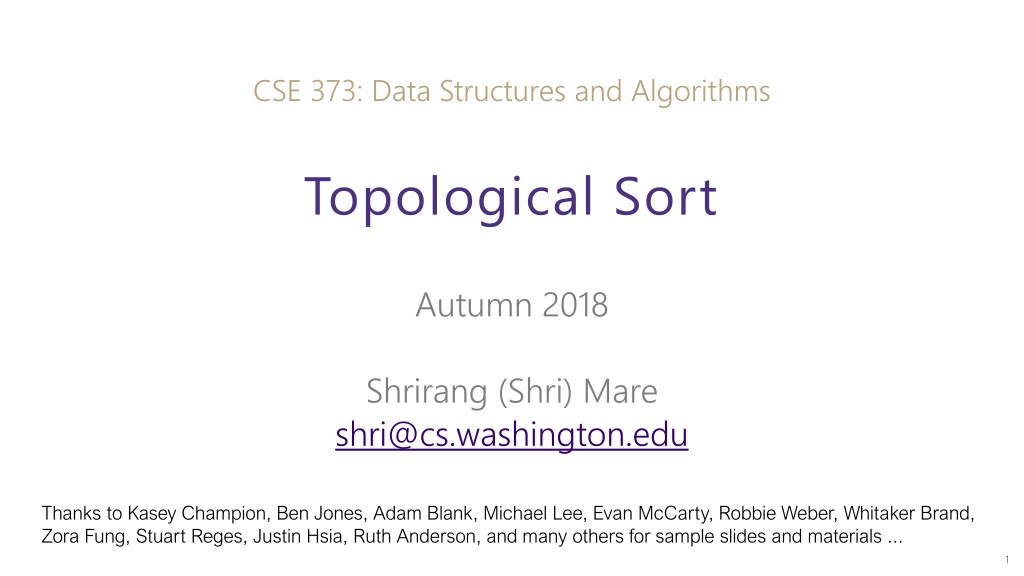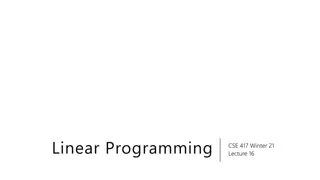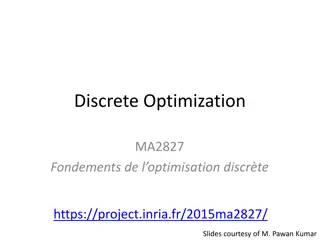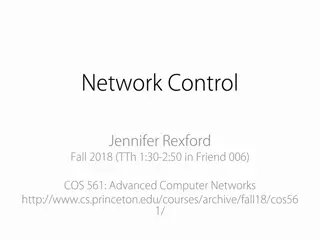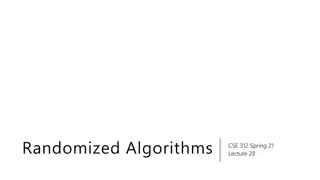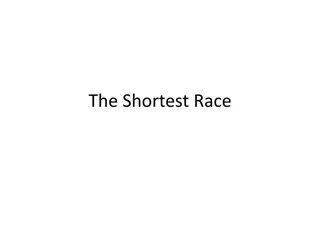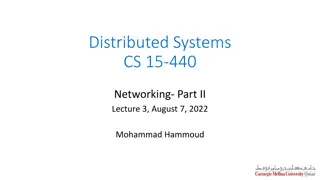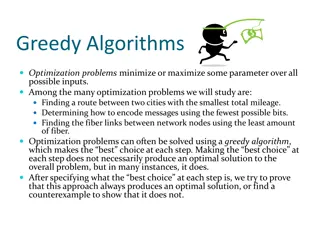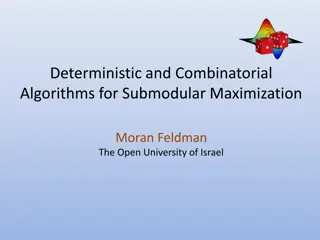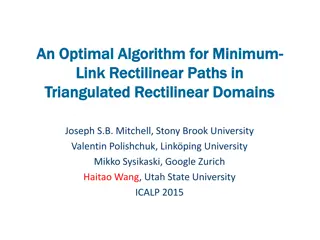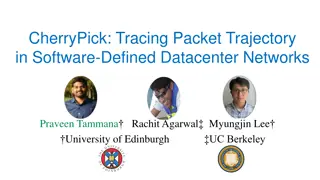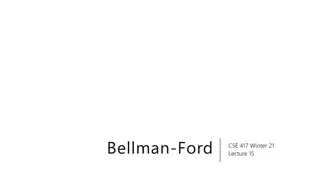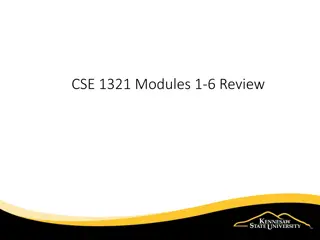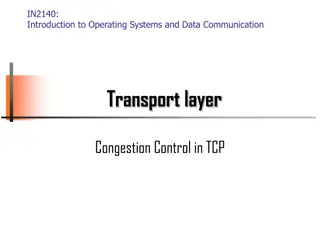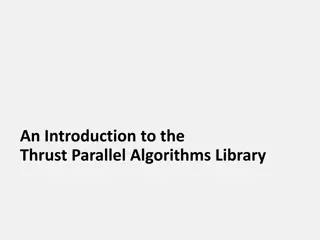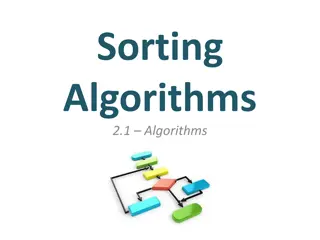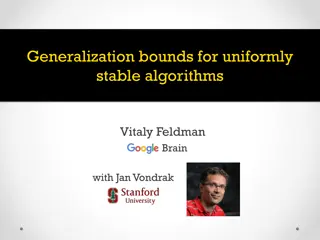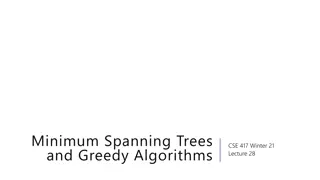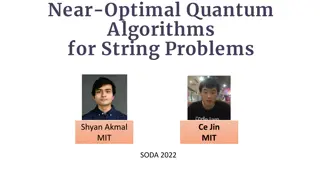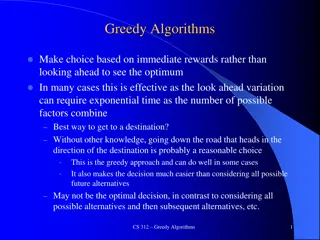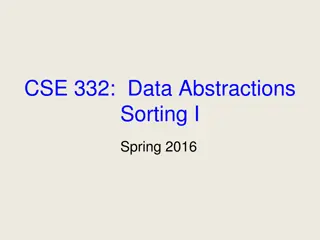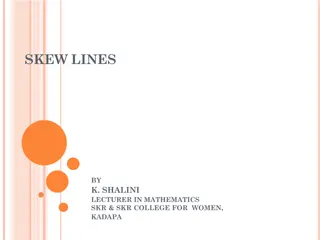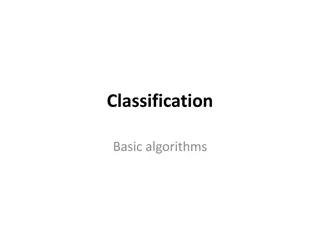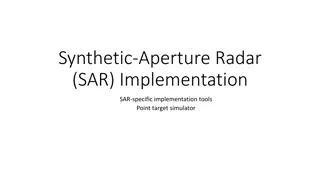Shortest Paths Algorithms and Applications Overview
This material covers various aspects of shortest path algorithms, focusing on Dijkstra's algorithm with binary heap and its time complexity. It delves into the history of shortest path algorithms, highlighting key authors and their contributions. Additionally, it explores different applications of shortest paths in areas such as Google Maps, robot navigation, urban traffic planning, and more. The content provides a comprehensive overview of how graphs can be utilized to solve problems related to pathfinding and optimization.
Download Presentation

Please find below an Image/Link to download the presentation.
The content on the website is provided AS IS for your information and personal use only. It may not be sold, licensed, or shared on other websites without obtaining consent from the author. Download presentation by click this link. If you encounter any issues during the download, it is possible that the publisher has removed the file from their server.
E N D
Presentation Transcript
CSE 373: Data Structures and Algorithms Topological Sort Autumn 2018 Shrirang (Shri) Mare shri@cs.washington.edu Thanks to Kasey Champion, Ben Jones, Adam Blank, Michael Lee, Evan McCarty, Robbie Weber, Whitaker Brand, Zora Fung, Stuart Reges, Justin Hsia, Ruth Anderson, and many others for sample slides and materials ... 1
Review Dijkstra s algorithm Vertex Distance Predecessor Processed B 5 1 T S 1 6 1 E C 1 CSE 373 AU 18 2
Review Dijkstra s algorithm Vertex Distance Predecessor Processed S 0 -- Yes B 1 S Yes C 6 S Yes E 2 B Yes T 3 E Yes B 5 1 T S 1 6 1 E C 1 CSE 373 AU 18 3
Running time analysis CSE 373 AU 18 4
History of shortest path algorithms Algorithm/Author Time complexity Year ?( ?2? ) Ford 1956 Bellman-Ford. Shimbel 1958 ?( ? ? ) Dijkstra s algorithm with binary heap 1959 ?( ? ??? ? + ? ???|?|) Dijkstra s algorithm with Fibonacchi heap 1984 ?( ? + ? log|?|) Gabow s algorithm 1990 ?( ? + ? log|?|) Thorup 2004 ?( ? + ? loglog|?|) History of shortest path algorithms. In this class, from this table, you are expected to know only Dijkstra s algorithm with binary heap and its time complexity. You are not expected to know the other algorithms or their time complexities. CSE 373 AU 18 5
Other applications of shortest paths Shortest path algorithms are obviously useful for GoogleMaps. The wonderful thing about graphs is they can encode arbitrary objects. arbitrary relationships among u I have a message I need to get from point s to point t. But the connections are unreliable. What path should I send the message along so it has the best chance of arriving? 0.7 0.8 s t 0.6 0.2 0.97 v Maximum Probability Path Problem Given: a directed graph G, where each edge weight is the probability of successfully transmitting a message across that edge Find: thepath from s to t with maximum probability of message transmission CSE 373 AU 18 6
Other applications of shortest paths Robot navigation Urban traffic planning Tramp steamer problem Optimal pipelining of VLSI chips Operator scheduling Subroutine in higher level algorithms Exploiting arbitrage opportunities in currency exchanges Open shortest path first routing protocol for IP Optimal truck routing through given traffic congestion CSE 373 AU 18 7
Topological Sort CSE 373 AU 18 8
Problem 1: Ordering Dependencies Given a bunch of courses with prerequisites, find an order to take the courses in. CSE 374 Math 126 CSE 143 CSE 142 CSE 373 CSE 417 Math 126 CSE 142 CSE 143 CSE 417 CSE 373 CSE 374 CSE 373 AU 18 9
Problem 1: Ordering Dependencies Given a directed graph G, where we have an edge from u to v if u must happen before v. We can only do things one at a time, can we find an order that respects dependencies respects dependencies? Topological Sort (aka Topological Ordering) Given: a directed graph G Find: an ordering of the vertices so all edges go from left to right. Uses: Compiling multiple files Graduating Manufacturing workflows (assembly lines) CSE 373 AU 18 10
Topological Ordering A course prerequisite chart and a possible topological ordering. CSE 374 Math 126 CSE 143 CSE 142 CSE 373 CSE 417 Math 126 CSE 142 CSE 143 CSE 417 CSE 373 CSE 374 CSE 373 AU 18 11
Can we always order a graph? Can you topologically order this graph? A B C Directed Acyclic Graph (DAG) A directed graph without any cycles. A graph has a topological ordering if and only if it is a DAG. CSE 373 AU 18 12
Ordering a DAG Does this graph have a topological ordering? If so find one. C D A B E If a vertex doesn t have any edges going into it, we can add it to the ordering. More generally, if the only incoming edges are from vertices already in the ordering, it s safe to add. CSE 373 AU 18 13
How Do We Find a Topological Ordering? CSE 373 AU 18 14
Whats the running time? CSE 373 AU 18 15
Connected [Undirected] Graphs Connected Component Connected Component a subgraph in which any two vertices are connected via some path, but is connected to no additional vertices in the supergraph - There exists some way to get from each vertex within the connected component to every other vertex in the connected component - A vertex with no edges is itself a connected component Connected graph Connected graph a graph where every vertex is connected to every other vertex via some path. It is not required for every vertex to have an edge to every other vertex There exists some way to get from each vertex to every other vertex Robb Sansa Rickon Dany Viserys Arya Jon Bran CSE 373 AU 18 17
Strongly Connected Components Strongly Connected Component A subgraph C such that every pair of vertices in C is connected via some path in both directions, and there is no other vertex which is connected to every vertex of C in both directions. A D E B C Note: the direction of the edges matters! CSE 373 AU 18 18
Strongly Connected Components Problem K A B D E C F J {A}, {B}, {C,D,E,F}, {J,K} Strongly Connected Components Problem Given: A directed graph G Find: The strongly connected components of G CSE 373 AU 18 19
SCC Algorithm Ok. How do we make a computer do this? You could: - run a [B/D]FS from every vertex, - For each vertex record what other vertices it can get to - and figure it out from there. But you can do better. There s actually an O(|V|+|E|) algorithm! I only want you to remember two things about the algorithm: - It is an application of depth first search. - It runs in linear time The problem with running a [B/D]FS from every vertex is you recompute a lot of information. The time you are popped off the stack in DFS contains a smart ordering to do a second DFS where you don t need to recompute that information. CSE 373 AU 18 20
Why Find SCCs? Graphs are useful because they encode relationships between arbitrary objects. We ve found the strongly connected components of G. Let s build a new graph out of them! Call it H - Have a vertex for each of the strongly connected components - Add an edge from component 1 to component 2 if there is an edge from a vertex inside 1 to one inside 2. D B E A K 1 2 F C J 4 3 CSE 373 AU 18 21
Why Find SCCs? D B E A K 1 2 F C J 4 3 That s awful meta. Why? This new graph summarizes reachability information of the original graph. - I can get from A (of G) in 1 to F (of G) in 3 if and only if I can get from 1 to 3 in H. CSE 373 AU 18 22
Why Must H Be a DAG? H is always a DAG (do you see why?). CSE 373 AU 18 23
Takeaways Finding SCCs lets you collapse If (and only if) your graph is a DAG, you can find a topological sort of your graph. collapse your graph to the meta-structure. Both of these algorithms run in linear time. Just about everything you could want to do with your graph will take at least as long. You should think of these as almost free preprocessing almost free preprocessing of your graph. - Your other graph algorithms only need to work on - topologically sorted graphs and - strongly connected graphs. CSE 373 AU 18 24
Appendix: Strongly Connected Components Algorithm
Efficient SCC We d like to find all the vertices in our strongly connected component in time corresponding to the size of the component, not for the whole graph. We can do that with a DFS (or BFS) as long as we don t leave our connected component. If we re a sink component, that s guaranteed. I.e. a component whose vertex in the meta- graph has no outgoing edges. How do we find a sink component? We don t have a meta-graph yet (we need to find the components first) DFS can find a vertex in a source component, i.e. a component whose vertex in the meta- graph has no incoming edges. - That vertex is the last one to be popped off the stack. So if we run DFS in the reversed graph (where each edge points the opposite direction) we can find a sink component. CSE 373 AU 18 26
Efficient SCC So from a DFS in the reversed graph, we can use the order vertices are popped off the stack to find a sink component (in the original graph). Run a DFS from that vertex to find the vertices in that component in size of that component time. Now we can delete the edges coming into that component. The last remaining vertex popped off the stack is a sink of the remaining graph, and now a DFS from them won t leave the component. Iterate this process (grab a sink, start DFS, delete edges entering the component). In total we ve run two DFSs. (since we never leave our component in the second DFS). More information, and pseudocode: https://en.wikipedia.org/wiki/Kosaraju%27s_algorithm http://jeffe.cs.illinois.edu/teaching/algorithms/notes/19-dfs.pdf (mathier) CSE 373 AU 18 27
